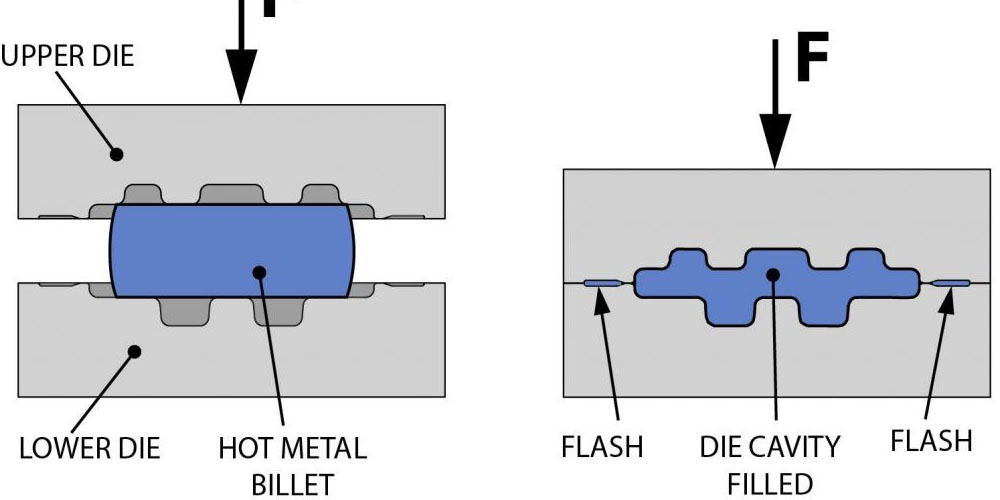Step 3: The forging process
The primary defining characteristic of the hot forging process is that it occurs at the highest temperature at which the metal does not get destroyed. This means that as much as the temperature is high, it must be to a capacity that it does not destroy the metal. Therefore, the temperature at which the hot forging process is performed usually depends on the metal used. This is essential because different metals have varying crystallization points.
The crystallization point is where new grains are formed in the metal. The temperatures are usually maintained throughout the process, depending on the metal. During the process, the metal is struck severally by a hammer until the desired shape is achieved. The high temperatures help make the process faster and easier. The hammers used in hot forging are usually sophisticated and specially designed to withstand the conditions.
Step 4: finishing and part removal
Once the desired shape and form are achieved, spare parts produced because of the stretching of the metal are trimmed. The part is then allowed to cool. Hot forging machines usually feature a cooling element. Finally, the part is removed from the machine using a conveyor belt or a robotic arm.
Conclusion
This forging technique is recommended for metals with high formability rations. The formability ratio is a measure of the ability of the metal to withstand deformation without forming defects. It is also an ideal technique for producing discrete parts.
Step 2: placing the metal piece in the die
The metal piece is usually placed at the middle of the die, with the hammer above it. This positioning allows the metal to adapt the shape on the die when struck by the hammer.
The friction process plays a significant role in this manufacturing technique. The forces oppose the metal spreading near the surfaces of the metal while allowing the center to expand.
Step 3: The forging process
The primary defining characteristic of the hot forging process is that it occurs at the highest temperature at which the metal does not get destroyed. This means that as much as the temperature is high, it must be to a capacity that it does not destroy the metal. Therefore, the temperature at which the hot forging process is performed usually depends on the metal used. This is essential because different metals have varying crystallization points.
The crystallization point is where new grains are formed in the metal. The temperatures are usually maintained throughout the process, depending on the metal. During the process, the metal is struck severally by a hammer until the desired shape is achieved. The high temperatures help make the process faster and easier. The hammers used in hot forging are usually sophisticated and specially designed to withstand the conditions.
Step 4: finishing and part removal
Once the desired shape and form are achieved, spare parts produced because of the stretching of the metal are trimmed. The part is then allowed to cool. Hot forging machines usually feature a cooling element. Finally, the part is removed from the machine using a conveyor belt or a robotic arm.
Conclusion
This forging technique is recommended for metals with high formability rations. The formability ratio is a measure of the ability of the metal to withstand deformation without forming defects. It is also an ideal technique for producing discrete parts.
Step 1: Making the die
The first step of the hot forging process is making the die. Note that the dies used in this manufacturing process are usually custom-made. The aim is to ensure that they match the designs provided by the client. Therefore, the dies have to be designed into the exact shape and form of the desired outcome. It is worth mentioning that the dies used in this process also have to undergo processes like thermal cycle and mechanical loading. When making hot forming dies, you have to ensure that they can withstand the thermal fatigue and intensity of the process.
Step 2: placing the metal piece in the die
The metal piece is usually placed at the middle of the die, with the hammer above it. This positioning allows the metal to adapt the shape on the die when struck by the hammer.
The friction process plays a significant role in this manufacturing technique. The forces oppose the metal spreading near the surfaces of the metal while allowing the center to expand.
Step 3: The forging process
The primary defining characteristic of the hot forging process is that it occurs at the highest temperature at which the metal does not get destroyed. This means that as much as the temperature is high, it must be to a capacity that it does not destroy the metal. Therefore, the temperature at which the hot forging process is performed usually depends on the metal used. This is essential because different metals have varying crystallization points.
The crystallization point is where new grains are formed in the metal. The temperatures are usually maintained throughout the process, depending on the metal. During the process, the metal is struck severally by a hammer until the desired shape is achieved. The high temperatures help make the process faster and easier. The hammers used in hot forging are usually sophisticated and specially designed to withstand the conditions.
Step 4: finishing and part removal
Once the desired shape and form are achieved, spare parts produced because of the stretching of the metal are trimmed. The part is then allowed to cool. Hot forging machines usually feature a cooling element. Finally, the part is removed from the machine using a conveyor belt or a robotic arm.
Conclusion
This forging technique is recommended for metals with high formability rations. The formability ratio is a measure of the ability of the metal to withstand deformation without forming defects. It is also an ideal technique for producing discrete parts.
Forging is the process of forming or deforming metal pieces to form parts. More often than not, the process involves a hammer or a ram moving horizontally to press against the metal piece. This movement causes the metal to widen and adapt the shape on the die beneath it. The die is usually designed based on the shape and form of the desired final part. There are two primary types of forging; hot and cold forging, while hot forging manufacturers are pretty prevalent. These manufacturers apply the hot forging process in a wide range of industries.
Understanding the hot forging process
The following is a comprehensive guide for the hot forging process;
Step 1: Making the die
The first step of the hot forging process is making the die. Note that the dies used in this manufacturing process are usually custom-made. The aim is to ensure that they match the designs provided by the client. Therefore, the dies have to be designed into the exact shape and form of the desired outcome. It is worth mentioning that the dies used in this process also have to undergo processes like thermal cycle and mechanical loading. When making hot forming dies, you have to ensure that they can withstand the thermal fatigue and intensity of the process.
Step 2: placing the metal piece in the die
The metal piece is usually placed at the middle of the die, with the hammer above it. This positioning allows the metal to adapt the shape on the die when struck by the hammer.
The friction process plays a significant role in this manufacturing technique. The forces oppose the metal spreading near the surfaces of the metal while allowing the center to expand.
Step 3: The forging process
The primary defining characteristic of the hot forging process is that it occurs at the highest temperature at which the metal does not get destroyed. This means that as much as the temperature is high, it must be to a capacity that it does not destroy the metal. Therefore, the temperature at which the hot forging process is performed usually depends on the metal used. This is essential because different metals have varying crystallization points.
The crystallization point is where new grains are formed in the metal. The temperatures are usually maintained throughout the process, depending on the metal. During the process, the metal is struck severally by a hammer until the desired shape is achieved. The high temperatures help make the process faster and easier. The hammers used in hot forging are usually sophisticated and specially designed to withstand the conditions.
Step 4: finishing and part removal
Once the desired shape and form are achieved, spare parts produced because of the stretching of the metal are trimmed. The part is then allowed to cool. Hot forging machines usually feature a cooling element. Finally, the part is removed from the machine using a conveyor belt or a robotic arm.
Conclusion
This forging technique is recommended for metals with high formability rations. The formability ratio is a measure of the ability of the metal to withstand deformation without forming defects. It is also an ideal technique for producing discrete parts.

